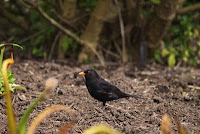Whooping Cranes by Kate Crowley
In my last column I wrote about snow geese – large, white, migratory waterfowl that have recovered far beyond anyone’s expectations from a severely depleted population. Another migratory waterfowl (wader) that replicates the white and black feather patterns of the snow goose is on the other end of the spectrum; struggling to recover from near extinction. Who am I talking about? Whooping cranes; that’s who. While still considered Endangered, they are gradually, through much human research, breeding and reintroduction programs, on the increase. At five feet, these magnificent, stately birds are the tallest in the North America . They have a wingspan of 7-8 feet, but only weigh between 11-16 pounds. Besides their white and black feathers, they also sport a bright red patch on their forehead, a black moustache and legs. They have a long, sharply pointed beak, typical of all cranes, the better to penetrate the thick marshy vegetation while they search for ...








